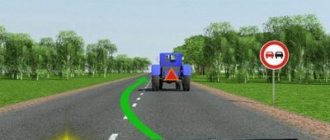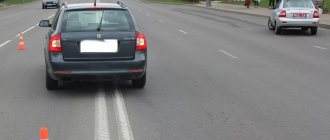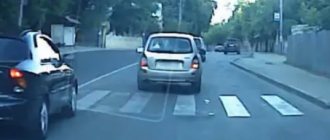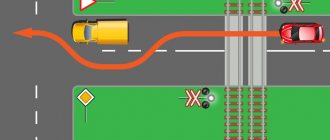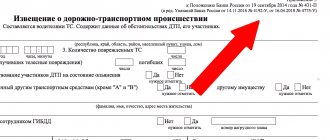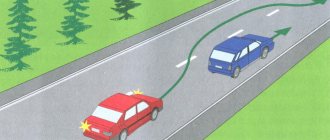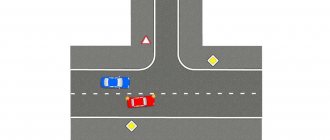Hello, friends! Today we answer a common question. We are talking about whether it is possible to overtake on a turn. More precisely, we will talk about dangerous turns.
When performing a maneuver that involves entering the oncoming lane, you need to be extremely careful and careful.
It is necessary to make sure that your actions are safe and eliminate the risk of getting into an accident. The overtaking person must also not create obstacles for other road users.
Especially when it comes to overtaking on a dangerous turn.
Things to remember
First, about the general rules and requirements for drivers overtaking.
Usually, in order to pass another car, drivers rely on markings and road signs. If there are no restrictions, then you can squeeze the gas to the floor and get ahead of your fellow traveler.
But the question is that overtaking is not always a permitted maneuver. Even in the absence of markings as such.
Many people are well aware that overtaking is prohibited at the end of a climb. Because driving into the oncoming lane can cause a serious accident. At any moment, another vehicle will come out from the other side of the rise. Due to the short distance between cars, it may be impossible to react to the situation in time.
Actual question
Motorists are wondering whether it is possible to overtake on a turn.
Here you should refer to paragraph 11.4 of the current traffic rules. The document states that overtaking is prohibited in the following situations:
- end of rise;
- Dangerous bend;
- other places with limited visibility.
The situation with the end of the rise is clear. Due to the bend in the road, visibility is very limited.
But there are other points. For example, when there is an open turn, overtaking is also prohibited by signs. Although visibility there is not limited by anything at 400-500 meters. Sometimes more.
And here doubt arises. Why, in the absence of objective obstacles, do they still put a prohibitory sign in a turn?
Now we need to discuss in detail overtaking when turning.
What will be the answer
According to the rules, the prohibition on the maneuver being performed, that is, overtaking, does not come into force from the place where the sign is installed. It starts only from the most dangerous section. Namely from the beginning.
If the traffic is outside populated areas, and there are no other overtaking prohibitions other than the sign, then drivers have about 150-300 meters to complete and complete the overtaking maneuver.
Yes, when the road bends, especially to the left, the driver’s visibility is not limited by anything when overtaking. The entire road is practically before your eyes. If the road is clear, there are no signs and/or road markings indicating that the maneuver is prohibited, then it is legally possible to perform it.
And here is the key point. This is a factor in the lack of signs or markings. That is, conditions prohibiting overtaking traffic.
If there is no sign 3.20 prohibiting overtaking before the turn, and the dividing strip is intermittent, then it is possible to perform a maneuver ahead of the front car.
But such areas are rare. It should be a smooth, almost perfect curve of the road, located in an open area. It is desirable that the markings are also absent.
In reality, each section of the road has its own characteristics. The bend happens:
- protracted;
- uneven;
- with changing terrain;
- with vegetation on the sides;
- covered by buildings, etc.
Therefore the review will be limited.
Visibility and height
At the same time, signs must comply with other standards.
The distance from the bottom edge of the sign (excluding plates) to the surface of the road surface (installation height) should be from 1.5 to 3.0 m when installed outside populated areas and from 2.0 to 4.0 m in populated areas. On traffic islands - from 0.6 to 1.5 m.
In accordance with paragraph 5.1.4, the visibility distance of the sign must be at least 100 meters. If it is obscured from view by tree branches, an advertising board, turned aside by the wind or vandals, covered in snow or hidden from view around a bend, then this is a direct violation of GOST.
Question answer
Is it possible to overtake if other cars are already overtaking ahead?
Important Additions
See also
Trailer KMZ 8136: technical specifications, photos, reviews
Let's take an example. There is a road outside the city. The area is quite open. The sign is 1.11.2. Indicates a dangerous turn. According to the rules, it is set 150-300 meters before the bend in the road. This sign is followed by 3.20. Informs about the prohibition of overtaking maneuvers.
A similar combination of signs is placed on sections of the road where there are insufficient conditions for visibility of oncoming traffic. That is, when oncoming cars may suddenly appear in the driver’s line of sight. Due to terrain or other visibility obstructions.
Cars are moving at high speed. Once in the oncoming lane, a motorist may not have time to return to his half of the road. The result is a head-on collision. That is why overtaking is prohibited during dangerous turns.
Prohibition signs are placed not at the beginning of dangerous areas, but at a distance. Within a populated area it is 50-100 meters. Outside the city 150-300 meters.
The driver, having seen a sign about a dangerous turn, manages to understand that there is a high-risk area ahead. You need to slow down, take your lane, and move only along it.
11.4 paragraph of the traffic rules prohibits overtaking in areas where there is a sign 1.11.1-1.12.2 (various types of dangerous turns). That’s why they don’t always add 3.20 in addition to it. You can limit yourself to a solid marking line. It also prohibits driving into the oncoming lane.
Sharp turn road sign
Traffic warning signs
You can tell if there is a sharp turn ahead by following. Therefore, you must always be attentive and focused while driving. At such moments, limited visibility can play a cruel joke.
In general, this is a very important section of the route for the driver, and especially in winter. As you know, at such a moment a centrifugal force acts on the car, tending to throw the car off the road. At the same time, speed becomes the most faithful ally of centrifugal force. If the speed doubles, then the centrifugal force quadruples.
The “Sharp bend in the road” sign is always installed on the roads, but you still need to be careful. The “Dangerous Turn” sign is a warning sign. Usually it is installed 100–300 meters before the turn so that the driver has time to prepare for it
It is important to know that overtaking when making a sharp turn is prohibited, but on the road from the sign to the beginning of the turn, overtaking is allowed
In conclusion, I would like to wish all drivers good luck on the roads and constant concentration. Driving a car is first of all a great responsibility, and only then a pleasure - remember this!
Prohibition signs introduce or remove certain traffic restrictions.
3.4 “Truck traffic is prohibited.”
The movement of trucks and vehicle combinations with a permissible maximum weight of more than 3.5 tons (if the weight is not indicated on the sign) or with a permissible maximum weight more than indicated on the sign, as well as tractors and self-propelled vehicles is prohibited.
Sign 3.4 does not prohibit the movement of trucks intended for the transport of people, vehicles of federal postal organizations having a white diagonal stripe on the side surface on a blue background, as well as trucks without a trailer with a permissible maximum weight of not more than 26 tons that serve enterprises located in the designated area. In these cases, vehicles must enter and exit the designated area at the intersection closest to their destination.
3.7 “Driving with a trailer is prohibited.”
It is prohibited to drive trucks and tractors with trailers of any type, as well as tow motor vehicles.
3.11 “Weight limitation”.
The movement of vehicles, including combinations of vehicles, the total actual weight of which is greater than that indicated on the sign, is prohibited.
3.12 “Limitation of mass per vehicle axle.”
It is prohibited to drive vehicles whose actual weight on any axle exceeds that indicated on the sign.
3.13 “Height limitation”.
The movement of vehicles whose overall height (with or without cargo) is greater than that indicated on the sign is prohibited.
3.14 “Width limitation”.
It is prohibited to drive vehicles whose overall width (laden or unladen) is greater than that indicated on the sign.
3.15 “Length limitation”.
The movement of vehicles (vehicle trains) whose overall length (with or without cargo) is greater than that indicated on the sign is prohibited.
3.17.2 “Danger”.
The further movement of all vehicles without exception is prohibited due to a traffic accident, accident, fire or other danger.
3.20 “Overtaking is prohibited.”
It is prohibited to overtake all vehicles except slow-moving vehicles, horse-drawn carts, bicycles, mopeds and two-wheeled motorcycles without sidecars.
3.26 “Sound signal is prohibited.”
It is prohibited to use sound signals, except in cases where the signal is given to prevent a traffic accident.
3.30 “Parking is prohibited on even days of the month.”
When signs 3.29 and 3.30 are used simultaneously on opposite sides of the roadway, parking is permitted on both sides of the roadway from 19:00 to 21:00 (rearrangement time).
3.32 “The movement of vehicles with dangerous goods is prohibited.”
The movement of vehicles equipped with identification signs (information plates) “Dangerous cargo” is prohibited.
What happens in the end
See also
Autobox Atlant: which one to choose, owner reviews
It turns out that overtaking on a turn is prohibited for a reason. Such maneuvers have a real risk of collision with other cars.
The signs do not infringe on the rights of drivers.
You also need to understand the following. Moving along a road with a dangerous bend from different sides, one will have a good view. This makes it puzzling why it is impossible to overtake here. But if you go from the other side, the situation there will be different. Visibility is much worse. And when trying to overtake, you may not notice oncoming traffic in a timely manner.
Another important thing to add. During dangerous turns, the prohibition on overtaking maneuvers applies in both directions. There is no such thing that you can get ahead of traffic in one direction by entering oncoming traffic, but not in the other. All drivers have equal rights.
Responsibility for overtaking when turning
The Code of Administrative Offenses does not specifically punish overtaking at a turn or intersection, but this does not mean that drivers who violate traffic rules will go unpunished. This offense will be classified as driving into oncoming traffic and will be punished under Part 4 of Art. 12.15 or part 5 of the same article in case of repeated violation.
They provide for the following penalties:
- fine 5000 rubles;
- confiscation of rights for 4-6 months;
- confiscation of rights for 12 months. (for repeated violation);
- fine 5000 rub. (for repeated violation, if it is recorded by an automatic camera).
Don't forget about the overtaking rules
If the road situation allows you to perform such a maneuver, that is, there are no prohibiting signs or markings, you still need to correctly overtake.
The technical rules for the maneuver in question are not specified in the traffic rules. In fact, they are not officially listed anywhere.
Here we are talking about established driving practice.
The technical rules provide for the following points:
- accelerate as much as possible within your lane;
- spend a minimum amount of time in the oncoming lane;
- return to your lane, but do not interfere with the car you overtook.
That is, the maneuver consists of 3 main stages. This is the beginning of overtaking itself, getting ahead, and also completing the action by returning to your part of the road.
